
 | ||||||||||||||||||||||||||||||
| ||||||||||||||||||||||||||||||
TOUCHWOOD
Newsletter of the Ranunculaceae Group
Spring 2012
A is for
Aquilegia ....and admirable, adorable, alluring, amazing, appealing, arresting,
astonishing, astounding, attractive, awe-inspiring................
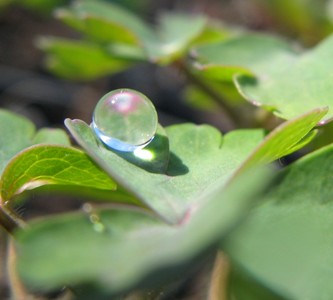
Is it the intricate, unusual shapes
of flower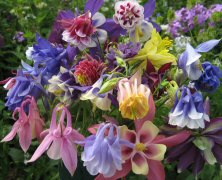 s
found in the Ranunculaceae that attracts us?
Certainly that was one of the reasons that drew me
to my first granny’s bonnet as a child, also the way it rapidly sprouted from
‘nothing’ each year with wonderfully shaped leaves that caught the raindrops and
made rolling balls of them.
As an adult I discovered that there is a
satisfyingly broad range of colours from white through reds and blues to the
darkest almost-blacks. Additionally there are many variations on the basic
flower shape within the genus, as well as additional flower shapes that have
been grown by cottage gardeners for centuries here in the UK.
s
found in the Ranunculaceae that attracts us?
Certainly that was one of the reasons that drew me
to my first granny’s bonnet as a child, also the way it rapidly sprouted from
‘nothing’ each year with wonderfully shaped leaves that caught the raindrops and
made rolling balls of them.
As an adult I discovered that there is a
satisfyingly broad range of colours from white through reds and blues to the
darkest almost-blacks. Additionally there are many variations on the basic
flower shape within the genus, as well as additional flower shapes that have
been grown by cottage gardeners for centuries here in the UK.
FLOWER SHAPES &
COLOURS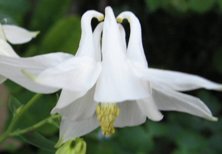
Let’s start with the simple, single
flowers. One of the common names, columbine, means ‘dove’: can you see the five
doves sitting in a circle in the photo?
Cultivars
of Aquilegia
vulgaris (a British native) comprise my first
National Collection. The wild form is a slightly-purpley blue, however selection
over
centuries now gives us a wide range of colours, including the delightful
white-centred bicolored ones, which look fantastic in the garden.
Aquilegia vulgaris
‘William Guiness’ (also known as ‘Magpie’) has a dramatic almost-black and white
flower, and lasts about 3-7 years.
I really like marbled blue, (marbled is the term I use when white is mixed in with the other colour of blue, purple or pink). Marbled blues range from a subtle ice blue through powder blue to a light indigo or denim colour.
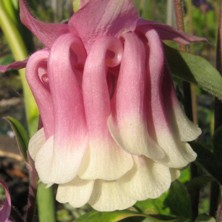 I
love the straight edges of the pleated doubles, luckily there’s loads to choose
from such as Strawberry Icecream is pink and white, and ‘Strawberry Milk’ is a
marbled pink.
I
love the straight edges of the pleated doubles, luckily there’s loads to choose
from such as Strawberry Icecream is pink and white, and ‘Strawberry Milk’ is a
marbled pink.
Other doubles have even more petals, such as marbled blue double ‘Tower Light Blue’. Pompom forms may have an amazing 100 petals instead of five!
Aquilegia vulgaris petals have hooked nectar
spurs and are pollinated by bumble bees. Around these cornucopia-shaped petals
are flat ‘petals’ which are actually sepals, and sometime these sepals (rather
than the petals) are doubled to give a spiky pompom effect.
One
particularly lovely one used to be known as the rose columbine, but is now
available as ‘Nora Barlow’. It has old-rose-pink sepals which shade through
cream to green at the tips. It is unique, do grow it, although there are
concerns that the ones grown currently are not so well formed or long lived as
the original of this name. Unlike many other aquilegias, ‘Nora Barlow’ tends to
come true from seed as, because there is no nectar, th
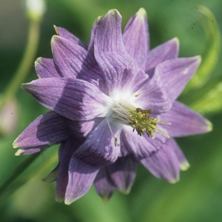 ere
is no insect cross-pollination. The same is true for all the Barlow relatives
now available, of which ‘Black Barlow’ is the most sultry. The white form is
available as ‘White Barlow’ and ‘Irish Elegance’ (anyone know the difference/s
between the two?). All white flowers are green in bud, and ‘Green Apples’ keeps
the green colouring for longer before aging to white.
ere
is no insect cross-pollination. The same is true for all the Barlow relatives
now available, of which ‘Black Barlow’ is the most sultry. The white form is
available as ‘White Barlow’ and ‘Irish Elegance’ (anyone know the difference/s
between the two?). All white flowers are green in bud, and ‘Green Apples’ keeps
the green colouring for longer before aging to white.
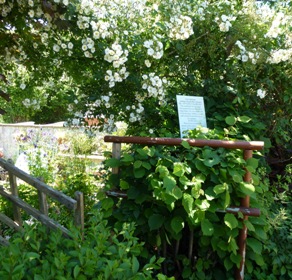
Come, now follow me over the stile into next doors garden, where my collection has over-spilled through lack of space here, careful, watch your step, as I tell you a little about my second National Collection.
There are many
species of Aquilegia, although I find none grow as well here as the
vulgaris
ones. Many do not even survive past their first winter (or even first summer) in
the conditions here in South Wales. Some alpines are specialist plants, but many
others also need conditions which I cannot supply here where all seedlings have
the same treatment (basically put into the garden soil as soon as possible and
grown on without any further attention that year).
Many
others are frustrating as they act as a biennial and die after flowering eg
Aquilegia
buergeriana ‘Calimero’, and many of the red &
yellow North American species. So when I grew some double forms from these
Americans, double yellows, double red & yellow, double orange & yellow, I was
interested but not enthusiastic. That changed when I looked at one and thought
‘that’s its THIRD year of flowering....it’s perennial!
I was hooked, again, by
aquilegias, this time doubles with yellow in (a colour which doesn’t occur with
A. vulgaris,
but abounds in many guises in the N American species). It’s now been many years
that I’ve bred these sorts but no strain has yet become stable enough to name. I
thought I was there once, and even ran a competition to name the
cultivar....only to find that the true-to-type offspring were proving much
shorter lived than the mother plant. A
‘flowers-then-dies-so-you-have-to-buy-more’ plant may be some seed-producer's
dream, but for me it’s a disappointment and a waste of time & resources, so
that’s one I’m still working on.
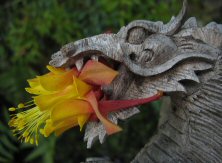
ncouraged.
The first such mix I sold was ‘Volcano!’ seed from
any double with yellow in, including apricots. As I now grow more of these
enticing plants, I’ve been able to separate them out even more, so 2011 saw the
launch of ‘Shooting Stars’ (yellow doubles) whereas this year I’m pleased to
offer ‘Dragon’s Breath’ (well coming from Wales, what else could I call it?)
taken from red & yellow double flowers.
With these last two expect about 20% to come ‘as
expected’ eg from ‘Dragon’s Breath’ you may get about a fifth with red & yellow
double flowers, however those flowers may be very different in shape, the way
they are held on the stem, the amount of doubling, and size of flower or plant
as well as the actual colour hues to their parent plant. What of the other 80%?
Well, there may be yellow, blushed yellow, pink and yellow, or apricot, singles
and doubles, as well as more ordinary sorts.
Better fun than any other lottery!
Time now to wend our way back out of
this small but crammed garden, past the nursery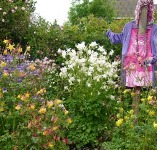 beds where over 1000 new plants are raised from seed each year, the tiny lawn
that gets tinier each year, the miracle bed that amazingly gave me more growing
space when I thought the garden was full, and back out to the lane in Clyne
Valley Country Park near National Cycle Route 4.
But wait, pause awhile here and chat with me a
little more, for what can this endearing plant be? Grown from seed purporting to
be Aquilegia caerulea, this beauty displays non of the colour or size
of bloom of its purported parent. It’s a white that is just slightly dif
beds where over 1000 new plants are raised from seed each year, the tiny lawn
that gets tinier each year, the miracle bed that amazingly gave me more growing
space when I thought the garden was full, and back out to the lane in Clyne
Valley Country Park near National Cycle Route 4.
But wait, pause awhile here and chat with me a
little more, for what can this endearing plant be? Grown from seed purporting to
be Aquilegia caerulea, this beauty displays non of the colour or size
of bloom of its purported parent. It’s a white that is just slightly different
in shape and tone to our A. vulgaris white, (shown in the photo to the
left of the unknown one) and is fairly long lived (about 5 years or so) and
appears to come true from seed, or at least true enough to distinguish it from
other whites.
Note I think the digital image
probably enhances the yellow tone slightly People have suggested
Aquilegia
buergeriana in one of its lighter forms (flavescens)
but that’s a species that has never been easy (or even likely) to survive here
let alone thrive. What can this mystery plant be? If you’ve ideas, do let me
know. My email (preferred) is
carrie.thomas@ntlworld.com or address is
Touchwood, 4 Clyne Valley Cottages, Killay, Swansea, SA2 7DU. To see more
aquilegias than you ever dreamed possible, do visit the Touchwood collections
which are usually at their best from mid May (A. vulgaris cultivars) to mid-June
(doubles with yellow). There’s loads to see also at the website
www.touchwoodplants.co.uk especially on the
aquilegia seedlist page, as well as practical help and information on sowing and
growing them.
Further information:
Columbines: Aquilegia, Paraquilegia & Semiaquilegia. Robert Nold, Timber press ISBN 0-88192-588-8
A Guide to Aquilegias: sowing, growing & breeding. 90 mins DVD, Carrie Thomas
| Back to top |
| More articles |
| Home | Seed-List | Aquilegias | Plants & Seedlings | Video | Contact me |
| Talks | Sowing | Gardening | Garden Visits | Labels | Order forms |
| Smudge | Articles | Essences | Greeting Cards | Healing | Links |
